Serviços Personalizados
Artigo
Links relacionados
Compartilhar
RGO.Revista Gaúcha de Odontologia (Online)
versão On-line ISSN 1981-8637
RGO, Rev. gaúch. odontol. (Online) vol.61 no.1 Porto Alegre Jan./Mar. 2013
ORIGINAL / ORIGINAL
Analysis of the surface behavior of polished and unpolished composite resins subjected to artificial accelerated aging
Análise do comportamento superficial de resinas compostas polidas e não polidas submetidas a envelhecimento artificial acelerado
Andréa Candido dos REISI; José Augusto Marcondes AGNELLIII; Alexandro NICOLUZZIIII; Carla Rodrigues MAZZOI
I Universidade de São Paulo, Faculdade de Odontologia.
II Universidade Federal de São Carlos, Centro de Ciências Exatas e de Tecnologia, Departamento de Engenharia de Materiais. São Carlos, SP, Brasil
III Universidade Vale do Rio Verde, Programa de Pós-Graduação em Clínica Odontológica.Três Corações, MG, Brasil
ABSTRACT
Objective
This study aimed to evaluate the occurrence of surface changes in composite resins, when subjected to surface treatment by polishing and artificial accelerated aging.
Methods
The changes were quantified through rugosimetric analysis and Scanning Electron Microscopy. Five composite resins were used (Charisma, Herculite, TPH, Z-250 and Supreme) and for each one, 32 samples were made, which were subdivided into four groups according to the surface treatment received: polished and aged, polished not aged, unpolished and aged and unpolished but not aged (control). The samples were obtained through a Teflon matrix with a diameter of 9 mm and height of 2 mm. For the polishing, the Sof-Lex Pop-On system (3M) was used and to execute the artificial accelerated aging, the Artificial Aging Machine (Comexim) was used, in which a 192 hours cycle was established, corresponding to an aging of five years. The Scanning Electron Microscopy analyses were performed under magnifications of 250x, 500x, 1000x and 2000x. All 120 samples were subjected to rugosimetric analysis through three parallel readings of each sample surface.
Results
The Kruskal Wallis statistical test showed statistically significant differences (p <0.05) only between the type TPH composite resins, polished and either with or without aging, for the average surface roughness.
Conclusion
The results showed that, for surface roughness, only the polished TPH resin showed significant differences when comparing aged and non- aged specimens. In addition, all the composite resins showed lower measurements of surface roughness when subjected to polishing treatment and higher when subjected to Artificial Aging.
Indexing terms: tratamento endodôntico; necrose pulpar; controle da infecção.
RESUMO
Objetivo
Avaliar a ocorrência de alterações superficiais em resinas compostas quando submetidas a tratamento superficial de polimento e envelhecimento artificial acelerado.
Métodos
As alterações foram quantificadas através de análise rugosimétrica e microscopia eletrônica de varredura. Foram utilizadas cinco resinas compostas (Charisma, Herculite, TPH, Z-250 e Supreme), e para cada uma delas confeccionados 32 corpos de prova que foram subdivididos em quatro grupos de oito de acordo com o tratamento superficial que receberam, sendo: polidos envelhecidos, polidos não envelhecidos, não polidos envelhecidos e não polidos não envelhecidos (controle). Os corpos de prova tinham dimensões de 9mm de diâmetro por 2mm de altura e foram obtidos através de uma matriz de teflon. Para o polimento empregou-se o sistema Sof-Lex Pop-On (3M) e para a realização do envelhecimento artificial utilizou-se a Máquina de Envelhecimento Artificial C-UV da Comexim na qual foi fixado um ciclo de 192 horas, que corresponde a cinco anos de envelhecimento. As análises ao Microscópio Eletrônico de Varredura foram realizadas com magnificações de 250x, 500x, 1,000x e 2.000x. Os 120 corpos de prova foram submetidos à análise rugosimétria através de três leituras paralelas na superfície de cada amostra.
Resultados
O teste estatístico de Kruskal Wallis mostrou diferenças estatisticamente significativas (p<0,05) somente entre as resinas compostas do tipo TPH polidas com ou sem envelhecimento para a rugosidade superficial média.
Conclusão
Os resultados permitiram concluir que na rugosidade superficial somente a resina TPH com polimento, mostrou diferenças significantes quando comparada envelhecida e não envelhecida e que todas as resinas compostas apresentaram medidas menores de rugosidade superficial, quando submetidas a polimento e maiores quando submetidas a Envelhecimento Artificial.
Termos de indexação: Resinas compostas. Polimento dentário. Microscopia Eletrônica de Varredura.
INTRODUCTION
In recent years, the high demand for esthetic treatments has increased industrial development in dentistry, culminating in the emergence of materials that simulate the characteristics of teeth. The market is replete with options, which creates doubt in the dental professional when the time comes to select a material which will provide esthetics and durability.
The study of the durability of esthetic materials is of great importance as the satisfactory performance of a restoration depends not only on its similarity to dental tissue but also on its resistance to degradation in the mouth1-3.
It is believed that the finishing and polishing phase helps to increase the durability of restorations, mainly with composite resins4, as they guarantee a surface smoothness which not only works on its esthetic characteristics but also on durability, as the pores make it increasingly difficult to clean, causing staining and potential reduction in the mechanical properties with the passing of time5.
Clinical studies have evaluated the behavior of restorative materials in the long term, however, with the oral condition of each patient as a variable, the standardization of evaluation is made more difficult since the chemical conditions of the mouth, the occlusion characteristics and the type of preparation are different for each patient. Another difficulty is the need to wait the required amount of time to observe the degradation of the materials in vivo.
In order to study the durability of these materials in the long term, this study proposes to analyze the surface behavior of photopolymerizable composite resins, with the presence of polishing and the action of time as variables, through roughness testing and analysis under a Scanning Electron Microscope.
METHODS
In order to carry out the tests, the following composite resins were used: Herculite XRV (Kerr, Washington, USA), Filtek Supreme (3M, Sumaré, Brazil), Filtek Z-250 (3M, Sumaré, Brazil), Charisma® (Heraeus Kulzer Hanau, São Paulo, Brazil) and Spectrum TPH (Dentsply, Petrópolis, Brazil). The specimens were made with a diameter of 9 mm and height of 2 mm from a polytetrafluoroethylene (Teflon).matrix. The filling of the matrix was carried out in one single increment, leveled with a glass slide and photopolymerized for the length of time recommended by the manufacturer, by means of a photopolymerizer (Gnatus Optilight 600 plus) that was placed at a distance of 0.5 cm from the surface of the composite resin. They then received surface treatment using the dental finishing and polishing system from Sof-Lex POP-ON (3M, Sumaré, Brazil)6-9, and then abraded using intermittent, interweaving movements with the moistening of the specimen's surface, with the aim of preventing the occurrence of superheating and consequent surface alteration.
Once the polishing was finished, the specimens were placed in the C-UV Artificial Accelerated Aging (AAA) appliance (Comexim Matérias Primas Ltda., Sumaré, Brazil). This appliance possesses a control system which offers the possibility of having daily programs with alternating condensation and UV-B radiation cycles. The operating program consisted of 4 hours of exposure to UV-B at 50º C and 4 hours condensation at 50º C and a maximum aging time of 192 hours which, according to the ASTM-G-53 standard, implies a period of 5 years of aging.
A total of 160 specimens was obtained, comprising 32 of each composite resin, divided into four groups of eight: polished and aged, polished but not aged, aged but not polished and neither polished nor aged.
After the AAA, two specimens from each group were put under the scanning electron microscope (SEM), Philips XL-30 FEG (Field Emission Gun).
The remaining 120 specimens were submitted for evaluation of average surface roughness (Ra) using the SJ.201P Roughness Tester (Mitutoyo Corporation, Japan). To this end, they were mounted on a wooden plate with an orifice to allow for adjustments.
For an evaluation of the influence, of factors like composite resin, polishing and aging and the interaction between them, on the measurement of the Average Surface Roughness, the Kruskal-Wallis non-parametric test was used for comparison of the measurements obtained.
RESULTS
Surface profilometry
The results demonstrated that there is a statistically significant difference (p<0.05) between the composite resins, either with or without aging, in respect of the measurement of average surface roughness, only in the case of the polished type of TPH, where the non-aged composite resins had significantly lower measurements than the aged composite resins. In addition, there is a statistically significant difference (p<0.05) between composite resins, either polished or unpolished, in respect of the measurement of average surface roughness, only in the case of the non-aged TPH, where the unpolished, composite resins showed significantly higher measurements than those that were polished.
There is no statistically significant difference (p>0.05) between the five types of composite resin when the factors polishing and aging are fixed, i.e. the five composite resins evaluated produced statistically similar readings of roughness, irrespective of polishing or aging.
Scanning Electron Microscopy
Scanning electron microscopy produced some surface differences when taking into account the polishing and aging treatments. However, the biggest difference in surface appearance occurred between the samples of TPH composite resins, as shown in figures 1 to 4.
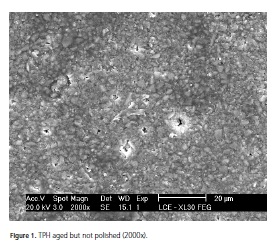
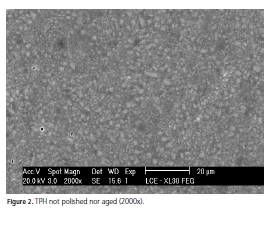
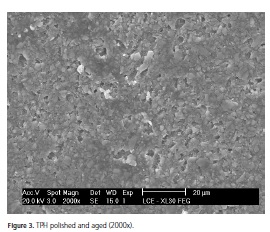
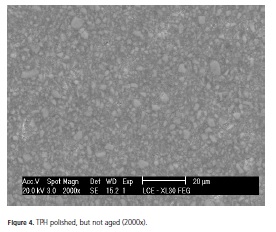
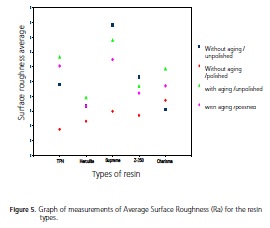
DISCUSSION
When a restoration using composite resin is performed with care, observing the technical exigencies, a situation of ostensibly satisfactory surface smoothness is promoted. However, the use of drill bits for finishing and disks for polishing, required to devolve shape and contour of the restorations, removes the surface portion of the polymer matrix which is polymerized last, which promotes an alteration in the durability of these restorations.
In order to predict the relative durability of the composite resins, the artificial accelerated aging system was employed, using elements that cause polymer degradation10-11, although it is known that the artificial aging process produces results which are less aggressive than those occurring in the oral environment, as masticatory forces, Ph variations and type of chewing would increase conditions of degradation.
The association of polishing in this study occurred in order to ascertain the influence of this clinical procedure on the durability of the composite resins.
When the results of this study only show statistically significant differences (p<0.05) between the composite resins of the polished TPH type, either with or without aging, in respect of the average surface roughness measurements, where the non-aged composite resins presented significantly lower readings than those that were aged, it can be seen how the action of time interferes with the surface behavior of these composites, irrespective of surface polishing treatment and that, in view of the methodology employed and analyses conducted, this does not help to prevent or diminish the composites' rate of aging, as it was not possible to perceive any correlation between these factors. Figure 5 provides a better view of the results. On the other hand, the fact that only the TPH composite resin is different from the others denotes that its components may be interacting differently from the others, suggesting a picture of greater surface instability.
Lastly, when the results show that there is no statistically significant difference (p>0.05) between the five types of composite resins, with the polishing and aging factors fixed, it is suggested that the formulations of the composites studied are very close, which is confirmed by the results of the scanning electron microscopy. It is known, however, that these composites may present alterations, in other trials, that were not produced in this study, reinforcing the positive factor in the development of dentistry5,10 and the importance of characterization testing for more in-depth studies11.
The microscopy demonstrated, through the images captured at magnifications of 250x, 500x, 1000x and 2000x, that the process of aging significantly affects the surface of the composite resins analyzed. The erosion of the matrix is characterized12 by the exposure of the load components, which contributes to the porosity of the composite resin surface, and degradation3 characterized by the breaking of chemical bonds. These modifications inevitably give rise to alterations such as the reduction in surface hardness, increase in the number of pores and characteristics of discoloration and staining2.
As for the surface treatment, it was possible to note that the polished, composite resins for all the makes analyzed, presented a greater degree of surface smoothness and a smaller number of pores than those that were not polished. These results suggest that polishing makes composite resins less susceptible to the effects of degradation through aging, thus increasing their clinical durability as the presence of surface irregularities increases the rate of degradation.
CONCLUSION
It was concluded that polished, composite resins presented a surface that was less rough than the unpolished surfaces, and the artificial accelerated aging method promotes surface roughness, irrespective of polishing.
The period of aging used caused a surface degradation that will lead to its replacement, or the need for treatment of the surface, due to the marked difference in coloration and roughness.
The performance of this study demonstrated that, despite the huge progress made with composite resins used in dental restorations, they still degrade in the oral environment.
Collaborators
AC REIS, JAM AGNELLI, A NICOLUZZI and CR MAZZO participated equally in the article, involved in all the stages of planning, execution, discussion and composition.
REFERENCES
1. Razaboni AM, Vinha D, Panzeri H. Associação de pontas rotatórias e discos de acabamento de compósitos. Rev Fac Farm Odontol Ribeirão Preto. 1983;20(1):1-6. [ Links ]
2. Gomes PN, Dias SC, Moyses MR, Pereira LJ, Negrillo BG, Ribeiro JC. Effect of artificial accelerated aging on Vickers microhardness of composite resins. Gen Dent. 2008;56(7):695-9. [ Links ]
3. Wendt SL Jr. The effect of heat used as secondary cure upon the physical properties of three composite resins. II. Wear, hardness and color stability. Quintessence Int. 1987;18(5):351-6. [ Links ]
4. D'arcangelo C & Delle Fratte T. Proposta di um método clinico per la refinitura dei restauri in resina compósita per mezzo di frese diamantate, dischi e stip abrasive: analisi al SEM. Minerva Estomatol. 1996;45(4):135-40. [ Links ]
5. Kawaguchi M, Fukushima T, Miyazaki K. The relationship between cure depth and transmission coefficient of visible-light-activated resin composites. J Dent Res. 1994;73(2):516-21. doi: 10.1177/00220345940730020601. [ Links ]
6. American Society for Testing and Materials. G 53. Standard Practice for Operating Fluorescent Ultraviolet (UV) Lamp Apparatus for Exposure of Nonmetallic Materials. Philadelphia: ASTM; 1996. [ASTM G154 - 12a] [ Links ].
7. Dijken JWV, Ruyter E. Surface characteristics of posterior composite after polishing and toothbrushing. Acta Odontolol Scand. 1987;45(5):337- 46. [ Links ]
8. Berastegui E, Canalda C, Brau E, Miquel C. Surface roughness of finished composite resins. J Prosthet Dent. 1992;68(5):742-9. doi: 10.1590/S0103-64402003000100007. [ Links ]
9. Chung KH. Effects of finishing and polishing procedures on the surface texture of resin composite. Dent Mater. 1994;10(5):325-30. doi: 10.1016/0109-5641(94)90041-8. [ Links ]
10. Mjor IA. Amalgam and composite resin restorations: longevity and reasons for replacement. In: Anusavice KJ. Quality evaluation of dental restorations: criteria for placement and replacement. Chicago: Quintessence Publishing Co.; 1989. p. 618. [ Links ]
11. Reis AC, Panzeri H, Agnelli JAM. Composite resin condensed manually and mechanically: characterization though thermal analysis. J Dent Res. 2001;80:608. [ Links ]
12. Powers JM, Fan PL, Raptis CN. Color stability of new composite restorative materials under accelerated aging. J Dent Res. 1980;59(12):2071-4. doi: 10.1177/00220345800590120801. [ Links ]
 Correspondence to:
Correspondence to:
AC REIS
Avenida do Café, s/n., 14040-904, Ribeirão Preto, SP, Brasil
e-mail: andreare73@yahoo.com.br
Received on: 24/3/2010
Final version resubmitted on: 17/9/2010
Approved on: 13/10/2010













